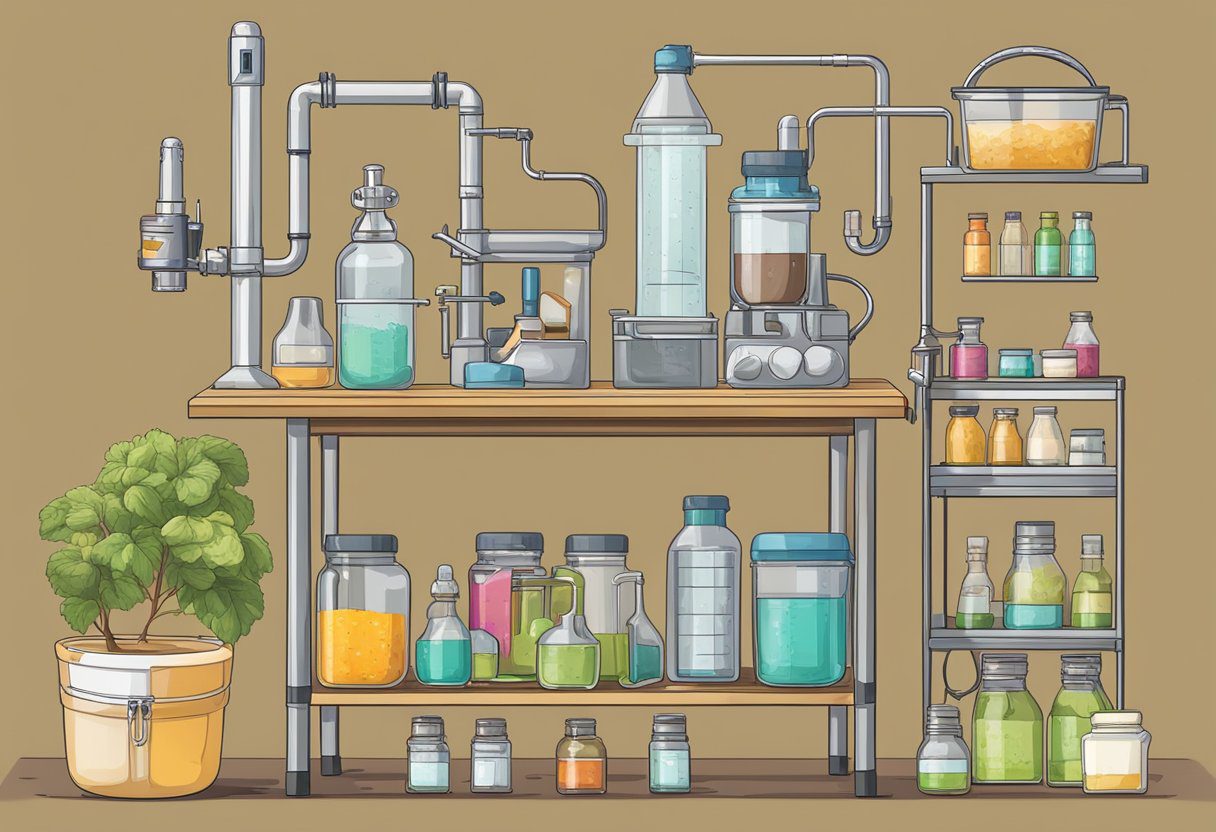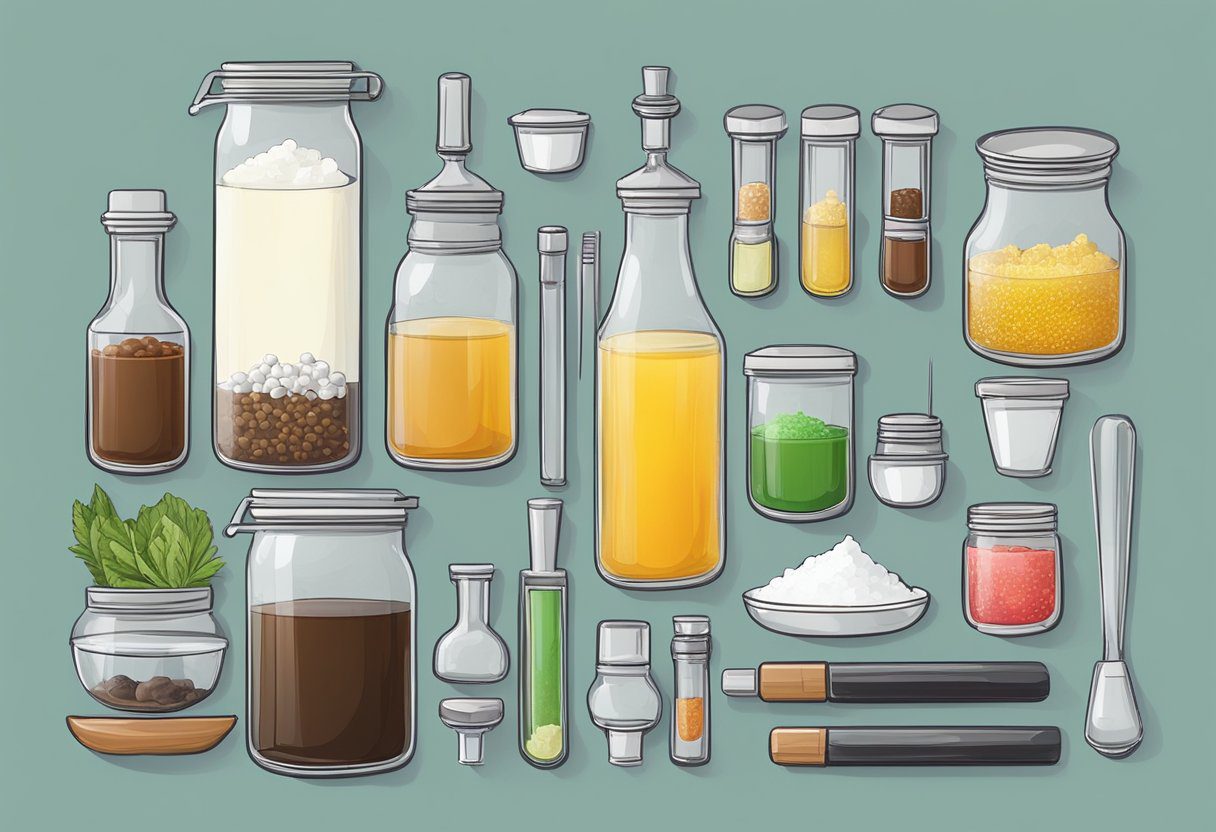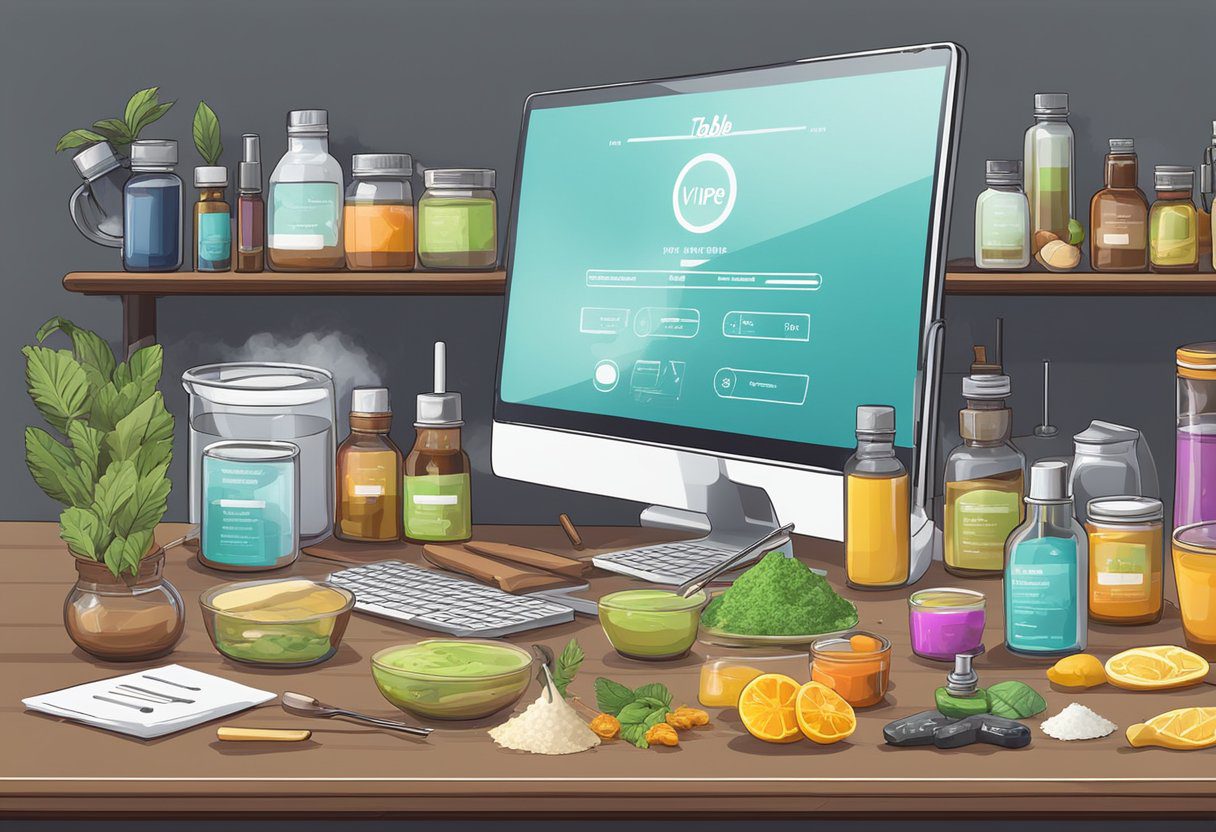DIY Vape Juice Made Easy: Mix Your Own Flavours
DIY vape juice is a great way to customise your vaping experience. It allows you to experiment with new flavours, mix your own nicotine levels, and ultimately save money. Making your own e-liquid can be a fun and rewarding experience, but it does require some knowledge and preparation.
Understanding vape juice is the first step in making your own e-liquid.
Vape juice is made up of four main ingredients: propylene glycol (PG), vegetable glycerin (VG), flavourings, and nicotine. PG and VG are the base liquids that create the vapor when heated, while flavourings and nicotine are added for taste and nicotine content. Safety and preparation are also important factors to consider when making DIY vape juice. It is important to have a clean workspace and follow safety guidelines to avoid any potential accidents.
Contents
- 1 Understanding Vape Juice
- 2 Safety and Preparation
- 3 DIY Mixing Basics
- 4 Flavouring Your Vape Juice
- 5 Bottling and Storage
- 6 Advanced Techniques
- 7 Additional Tips and Tricks
- 8 Troubleshooting Common Issues
- 9 Conclusion
- 10 Frequently Asked Questions:
- 10.1 What ingredients are required to create homemade vape juice?
- 10.2 Is it possible to prepare vape juice using items commonly found at home?
- 10.3 How can one produce vape juice without including nicotine?
- 10.4 What are the alternatives to glycerin when making vape juice at home?
- 10.5 Are there any DIY vape juice kits available for purchase online?
Key Takeaways
- Understanding the basics of vape juice is essential before making DIY e-liquid.
- Safety and preparation are important factors to consider when making DIY vape juice.
- DIY vape juice allows for customisation and experimentation with flavours and nicotine levels.
Understanding Vape Juice
Vape juice, also known as e-juice or e-liquid, is a flavoured liquid that is used to create vapour in electronic cigarettes. Understanding the components of vape juice is essential in making your own DIY vape juice.
Components of E-Liquid
The main components of vape juice are propylene glycol (PG), vegetable glycerin (VG), nicotine, and flavourings. PG is a colourless and odourless liquid that is used to carry flavour and provide a throat hit. VG is a thicker liquid that produces more vapour and provides a smoother hit. Flavourings can be natural or artificial and are added to create different tastes.
PG/VG Ratios Explained
The PG/VG ratio is an important factor to consider when making DIY vape juice. A higher PG ratio will result in a stronger throat hit and a more flavourful vape, while a higher VG ratio will produce more vapour and a smoother hit. The most common PG/VG ratios are 50/50, 70/30, and 80/20.
Nicotine and Its Role
Nicotine is an optional component in vape juice and is added to create a desired nicotine strength. Nicotine strength is measured in milligrams per millilitre (mg/ml) and can range from 0mg/ml to 20mg/ml. It is important to note that nicotine can be harmful and should be handled with care.
In conclusion, understanding the components of vape juice is crucial in making your own DIY vape juice. The PG/VG ratio and nicotine strength are important factors to consider when creating your own vape juice. By experimenting with different ratios and flavours, one can create a unique and enjoyable vaping experience.
Safety and Preparation
When making DIY vape juice, safety and preparation are crucial to ensure a successful and safe mixing experience. This section covers the essential safety practices, mixing supplies, and hygiene protocols that need to be followed to create a safe and enjoyable vaping experience.
Creating a Safe Workspace
Firstly, it is essential to create a safe workspace when making DIY vape juice. This means finding a clean, well-ventilated area that is free from any flammable materials. It is also important to ensure that the workspace is free from distractions and that there is enough space to move around comfortably.
Essential Mixing Supplies
When making DIY vape juice, it is important to have the right mixing supplies. This includes gloves, syringes, pipettes, measuring cups, and a scale. Gloves are particularly important when handling nicotine, as it can be harmful if it comes into contact with the skin. All of these supplies should be clean and free from any contaminants.
Hygiene and Safety Protocols
Hygiene and safety protocols are essential when making DIY vape juice. This includes washing your hands thoroughly before starting the mixing process and wearing gloves throughout the entire process. It is also important to label your bottles correctly to avoid any confusion and ensure that the nicotine strength and flavour are clearly marked.
In conclusion, when making DIY vape juice, safety and preparation are essential. Creating a safe workspace, having the right mixing supplies, and following hygiene and safety protocols will ensure a successful and safe mixing experience. By following these guidelines, vapers can enjoy a satisfying and enjoyable vaping experience.
DIY Mixing Basics
Mixing your own vape juice can be a fun and rewarding experience. It allows you to experiment with different flavours and nicotine strengths to find the perfect blend for your vaping needs. However, it’s important to understand the basics of DIY mixing to ensure that you get the best results.
Measuring Ingredients Accurately
One of the most important aspects of DIY mixing is measuring your ingredients accurately. This is essential to ensure that your e-liquid is consistent and safe to vape. There are two main methods for measuring ingredients: mixing by weight and mixing by volume.
Mixing by weight involves using a scale to weigh each ingredient. This method is more accurate and precise, and it’s recommended for more experienced mixers. Mixing by volume involves using syringes or pipettes to measure each ingredient. This method is easier for beginners, but it’s less accurate and can lead to inconsistent results.
Understanding Mixing Ratios
Another important aspect of DIY mixing is understanding mixing ratios. Mixing ratios refer to the proportion of each ingredient in your e-liquid recipe. For example, a 70/30 VG/PG ratio means that your e-liquid contains 70% vegetable glycerine and 30% propylene glycol.
It’s important to understand mixing ratios because they can affect the flavour, throat hit, and vapour production of your e-liquid. Different flavours and nicotine strengths may require different mixing ratios, so it’s important to experiment to find the perfect blend for your needs.
When mixing your e-liquid, it’s important to use high-quality ingredients, such as pharmaceutical-grade nicotine and food-grade flavourings. You should also use distilled water to dilute your e-liquid if necessary, as tap water can contain impurities that can affect the flavour and quality of your e-liquid.
By following these basic mixing principles and experimenting with different flavours and ratios, you can create your own unique and delicious e-liquid blends.
Flavouring Your Vape Juice
Flavouring your e-juice is where the real creativity begins. There are a vast array of flavourings available, allowing you to create unique flavours that suit your taste.
Choosing Your Flavours
When choosing your flavours, it’s important to keep in mind that some flavours are more potent than others. For instance, fruit flavours tend to be more potent than dessert flavours. It’s also important to consider the PG/VG ratio of your base mixture, as this can affect the potency of your flavours.
Some popular flavours include:
- Fruits: strawberry, blueberry, raspberry, mango, watermelon
- Desserts: vanilla, chocolate, caramel, custard, cheesecake
- Beverages: coffee, tea, cola, lemonade, energy drink
Flavour Combinations and Potency
When it comes to flavour combinations, the possibilities are endless. However, it’s important to keep in mind that some flavours work better together than others. For instance, fruit flavours tend to work well together, while mixing a fruit flavour with a dessert flavour may not produce the desired result.
It’s also important to consider the potency of your flavours. Some flavours are more potent than others, and using too much of a potent flavour can overpower the other flavours in your mixture. It’s recommended to start with a small amount of flavouring and gradually increase it until you achieve the desired taste.
Overall, flavouring your e-liquid is a fun and creative process that allows you to create unique flavours that suit your taste. With a little experimentation and creativity, you can create e-liquid that is truly one-of-a-kind.
Bottling and Storage
Once the e-liquid has been mixed and steeped, it’s time to bottle and store it properly. Here are some tips to ensure that the vape juice stays fresh and flavorful for as long as possible.
Transferring to Storage Bottles
The first step is to transfer the e-liquid from the mixing container to storage bottles. It’s important to use clean and sterile bottles to prevent contamination. Plastic bottles are a popular choice for storing e-liquid as they are lightweight, durable, and easy to squeeze. Empty bottles can be purchased from most vaping stores, or you can reuse old bottles after cleaning and sterilising them thoroughly.
When transferring the e-liquid to the storage bottles, it’s important to leave some room at the top. This allows for air to circulate inside the bottle and helps with steeping. It’s also a good idea to label the bottles with the flavour and nicotine strength so that you can keep track of what you have.
Proper E-Liquid Storage Techniques
Once the e-liquid has been transferred to the storage bottles, it’s important to store them properly. E-Liquid should be kept in a cool, dark place away from direct sunlight. Exposure to light and heat can cause the flavour and nicotine to degrade over time. It’s also important to keep the vape juice away from children and pets.
One way to store vape juice is to use a dedicated vape juice storage box. These boxes are designed to keep the vape juice in a cool and dark environment and are often made from materials like wood or metal. If you don’t have a storage box, you can also use a cupboard or drawer to keep the vape juice out of direct sunlight.
In summary, transferring and storing vape juice properly is key to ensuring that it stays fresh and flavourful for as long as possible. By using clean and sterile bottles and storing the vape jucie in a cool and dark place, you can enjoy your DIY vape juice for weeks or even months to come.
Advanced Techniques
Steeping for Enhanced Flavour
Steeping is the process of allowing your DIY vape juice to sit and age for a period of time. This process allows the flavours to blend together and mature, resulting in a smoother and more complex flavour profile. There are different methods of steeping, such as using a warm water bath or leaving the juice to sit in a cool, dark place for a few days or weeks. You can experiment with different steeping methods to find what works best for you.
Adjusting for Desired Throat Hit
Throat hit refers to the sensation of the vapour hitting the back of your throat when you inhale. Some vapers prefer a strong throat hit, while others prefer a smoother inhale. You can adjust the throat hit of your DIY vape juice by altering the ratio of PG (propylene glycol) and VG (vegetable glycerin) in your mix. Increasing the PG ratio will result in a stronger throat hit, while increasing the VG ratio will result in a smoother inhale.
Experimenting with Large Batches
Once you have mastered the basics of DIY vape juice, you can experiment with making larger batches. This allows you to have more control over the consistency and flavour of your juice. When making large batches, it is important to keep track of your measurements and take notes on your process. This will help you replicate your successful batches and avoid mistakes in the future.
Overall, mastering advanced techniques in DIY vape juice requires trial and error. It is important to keep experimenting and adjusting until you find the perfect balance of flavour, throat hit, and consistency. With practice and patience, you can create a unique and satisfying vape juice that is tailored to your preferences.
Additional Tips and Tricks
Using Diluted Nicotine
Nicotine is an essential ingredient in vape juice, but it can be dangerous to handle in its concentrated form. Diluted nicotine is a safer option and can be easily incorporated into your DIY vape juice. It is essential to use the correct nicotine strength for your e-liquid, as too much nicotine can be harmful.
When working with diluted nicotine, it is essential to wear gloves and handle it with care. Nicotine can be absorbed through the skin, so it is crucial to avoid direct contact. It is also important to store diluted nicotine in a cool, dark place away from children and pets.
Incorporating Additives
Additives can be used to enhance the flavour and throat hit of your DIY vape juice. Essential oils, alcohol, and menthol are popular additives that can be used in small amounts to add a unique twist to your e-liquid. However, it is essential to use high-quality, food-grade additives and to avoid using too much, as this can affect the overall quality of your e-liquid.
When incorporating additives, it is important to do so in small amounts and to test the e-liquid before using it. It is also essential to avoid using additives that are not intended for vaping, as this can be harmful to your health.
Overall, making DIY vape juice can be a fun and rewarding experience. By following the correct procedures and using high-quality ingredients, you can create a unique e-liquid that is tailored to your individual preferences.
Troubleshooting Common Issues
Making your own vape juice can be a rewarding and creative experience, but it can also be tricky. Here are some common issues that you might encounter while creating your DIY vape juice, along with some solutions to help you troubleshoot them.
Addressing Flavour Issues
One of the most common issues that DIY vapers face is getting the right flavour. If you find that your vape juice tastes too weak or too strong, there are a few things that you can do to adjust it.
- Too Weak: If your vape juice tastes too weak, try adding more flavour concentrate. You can also try steeping your e-liquid for a longer period of time to allow the flavour to develop.
- Too Strong: If your vape juice tastes too strong, try diluting it with some more base liquid. You can also try steeping your e-liquid for a shorter period of time to reduce the intensity of the flavour.
Solving Mixing Inconsistencies
Another common issue that DIY vapers face is getting a consistent mix. If you find that your vape juice is separating or has an inconsistent flavour, there are a few things that you can do to fix it.
- Shake Well: Make sure that you shake your vape juice well before using it. This will help to ensure that all of the ingredients are evenly distributed.
- Use an E-Liquid Calculator: Using an e-liquid calculator can help you to get a more accurate mix. This will ensure that you are using the right amounts of each ingredient, which can help to prevent inconsistencies.
- Tissue Method: You can also try the tissue method to help mix your vape juice. Simply put your vape juice in a plastic bag with a tissue, and then shake it vigorously for a few minutes. This will help to ensure that all of the ingredients are evenly distributed.
By following these tips, you can troubleshoot some of the most common issues that DIY vapers face. Remember, making your own vape juice can be a fun and rewarding experience, so don’t be afraid to experiment and try new things!
Conclusion
Making your own DIY vape juice can be a rewarding and cost-effective approach to enhance your vaping experience. Understanding the preparation and formula of e-liquid is crucial to making a high-quality product. By following the correct steps, you can tailor your vape juice to your preferences and create unique flavours that you can’t find anywhere else.
The process of making e-liquid involves measuring and mixing ingredients, and it is important to be precise with the measurements. Using an e-liquid calculator can be helpful in ensuring that you have the right ratios of ingredients. The type of vaping experience you want to achieve can be determined by the ratio of vegetable glycerin (VG) and propylene glycol (PG) used in the mixture.
When making your own vape juice, it is important to understand the safety precautions involved. Always wear protective gear, such as gloves and goggles, and keep the area clean and well-ventilated. Nicotine can be dangerous if not handled properly, so it is important to be careful when working with it.
Overall, making your own vape juice can be a fun and creative process. By following the correct approach and preparation, you can create a product that is tailored to your preferences and vaping style. It is important to understand the ingredients and formulas involved, as well as the safety precautions needed. With the right knowledge and tools, you can create a high-quality vape juice that enhances your vaping experience.












Leave a Reply